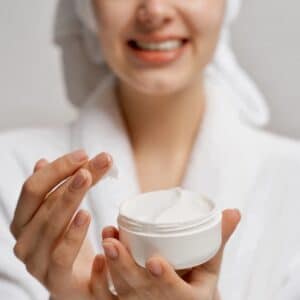Making your own moisturizer is a way to get to know your skin and the ingredients that support it better, and it’s more than just a hobby. When you start making your own skin care products, you realize that each oil, butter and extract has a specific function. Each combination of textures and fragrances you choose helps create something unique and important. A handmade natural moisturizer is about creating a formula that reflects your values and cares for your skin, not just providing hydration.
Knowing exactly what ingredients are in your own moisturizer is what makes it so wonderful. From the base oils to the mild scent of essential oils, you choose each ingredient to ensure the final product suits your skin type and lifestyle. Knowing how to safely and effectively make a moisturizer gives you complete control over your skincare routine, whether you prefer a rich cream for dry skin or something light for daily use.
Why it’s important to make your own moisturizer
Most commercial creams use artificial stabilizers, silicones or preservatives to extend their shelf life, which can sometimes come at the expense of the skin’s natural balance. By making your own
Making your own moisturizer is important for more reasons than just the ingredients: awareness. You won’t look at skin care labels the same way once you know how a formula is composed of water, oil, emulsifier, preservative and active ingredients. You can then distinguish between products that just coat your skin and those that actually moisturize your skin.
With a homemade moisturizer, you can also adjust the texture and speed of absorption. Want something that is smooth and absorbs quickly? Then use lighter oils, such as grapeseed oil or jojoba. Need extra protection for mature or dry skin? Add a small amount of cocoa or shea butter for extra richness. The procedure is flexible, powerful and surprisingly innovative.
Essential natural ingredients for moisturizer
A good natural moisturizer is a balance of hydration and nutrition. To achieve that, you need a blend of water-loving and oil-based ingredients that work together in harmony.
1. Hydrating components
Start with a water base, such as aloe vera juice, floral hydrosols (such as chamomile or rose) or distilled water. These serve as a moisturizing base for your cream. To help your skin retain moisture longer, you can also add humectants such as glycerin or hyaluronic acid.
2. Nourishing oils and butters
Vegetable oils provide softness and comfort. Light and suitable for most skin types are sweet almond oil, apricot kernel oil or sunflower oil. Shea butter, mango butter or cocoa butter offer a rich, smooth texture that retains moisture for deeper nourishment. Simple, pure and packed with natural fatty acids that support the skin barrier, these are the key ingredients in your natural moisturizer.
3. Emulsifiers and thickeners
To blend water and oil into a stable cream, use a natural emulsifier such as Olivem 1000, Emulsan or beeswax-based alternatives. These give your moisturizer a smooth, creamy consistency and help maintain its texture over time.
4. Essential oils and active ingredients.
Adding a little essential oil has benefits for the skin in addition to the fragrance. Geranium balances, lavender soothes and frankincense revitalizes. You can add plant actives such as vitamin E or panthenol (provitamin B5) for even more personalization. For safety, always choose cosmetic oils and keep the dosage low, especially for essential oils.
Each ingredient you choose has a specific function. If you start experimenting, you will quickly see how these natural moisturizer ingredients elevate a basic blend into a professional-quality skincare product.
Tips for safely making moisturizer at home
When making moisturizer at home, you must be precise, patient and clean. If you ignore proportions or hygiene, a beautiful, natural formula can spoil quickly. Always start by cleaning your jars, bowls and spatulas. If your tools are clean, no mold or bacteria can grow in your product. Make sure you have everything you need within easy reach at your workstation and use a digital scale to accurately weigh your ingredients.
After heating the oil and water phases separately to about 70 °C, mix them gradually while stirring. This helps ensure proper binding of both phases by the emulsifier. You can add delicate ingredients such as essential oils or heat-sensitive actives once the mixture has cooled to about 40 °C. Increase the water phase slightly if you want your moisturizer to be light and soft. Add additional butter or oil for thicker, creamier creams.
Label your product with the date and store it in airtight jars or pump bottles to keep it fresh. The shelf life can be extended with a mild natural preservative, especially for formulas that contain water. Your moisturizer will stay effective and fresh if you make it in small quantities.
How to choose the best ingredients for your skin type
One of the advantages of making moisturizer yourself is that you can customize it to your own needs.
Each skin type benefits from different natural ingredients:
- Dry skin: shea butter, avocado oil or argan oil provide deep nourishment.
- Oily or combination skin: jojoba oil, grapeseed oil and aloe vera gel moisturize without feeling heavy.
- Sensitive skin: chamomile hydrosol, oat extract and a few drops of lavender oil provide calmness and comfort.
Consider texture and absorption; not every oil is suitable for every skin. By testing small amounts, you can find the perfect combination for your needs. Over time, you will find that your homemade creations are more balanced and better suited to your skin than creams from the store.
Stability and safety: keeping your natural moisturizer fresh
A natural moisturizer is alive in a way that synthetic products are not; it changes over time, just like fresh food. To ensure stability, avoid exposing the cream to high temperatures or direct sunlight. Always use clean hands or a spatula to apply the cream and make sure the lid is tightly closed. Preservation is essential. Even natural products can contain bacteria if they contain water. A natural preservative such as Geogard Ultra or Leucidal will help keep your moisturizer safe for several months. Always check the pH level and store your cream in a cool, dry place.
Safety also means testing your finished product on a small patch of skin before using it regularly. This is especially important if you are adding new natural moisturizer ingredients, such as essential oils or botanical extracts.
Why natural is not the same as simple: it means smarter
A common misconception is that making natural cosmetics is easier than producing them for the market. In reality, awareness and knowledge are required to create a stable, safe, natural moisturizer. Knowing the pH, compatibility and properties of your ingredients will ensure that your formula is both mild and effective.
However, the goal of this process is empowerment, not overwhelm. You become more confident in your own abilities when you understand how ingredients work. You take on the role of creator, tester and formulator. With each batch, you learn something new about texture, fragrance or stability.
At YouWish, we believe that using natural skin care products should be fun and affordable. High quality natural ingredients and the right information are all you need to succeed whether you’re learning to make your own moisturizer or want to start your own line.
Frequently Asked Questions
V1. How long does a homemade moisturizer last?
The average shelf life of a natural moisturizer made with hygienic ingredients and minimal preservatives is two to three months. Always store the cream in a cool, dry place and use a spatula instead of your fingers to keep it fresh.
V2. What are the best natural ingredients for a moisturizer?
Shea or cocoa butter provides a rich texture, and vegetable oils such as jojoba, almond and grapeseed oils are super for hydration. To improve moisture balance and texture, you can also add vitamin E, glycerin and aloe vera.
V3. Can I make a moisturizer without preservatives?
You can omit preservatives if your formula does not contain water. However, for water-based moisturizers, a mild natural preservative helps to prevent mold and bacteria, keeping your cream stable and safe.
V4. Are essential oils necessary in a natural moisturizer?
They can add extra benefits and fragrance, but are not necessary. For a pleasant and balanced natural moisturizer, use very small amounts of skin-friendly ingredients such as chamomile or lavender.
Conclusion: create with nature, trust and care
Making your own moisturizer is more than just combining water and oils; it’s creating an experience. Your inventiveness and knowledge of how nature benefits the skin are reflected in every jar of natural moisturizer you make. You can make a moisturizer that is long-lasting, effective and unique by using the right natural ingredients. Making skin care products doesn’t have to be difficult. Choose pure ingredients, start small and use clean tools. As you gain more knowledge, you will discover that you are not just following recipes, but creating your own. That’s where the true magic of DIY skin care begins.
At YouWish, we’re here to support you at every stage, from selecting the ideal essential oils for your regimen to learning about nourishing butters and carrier oils. Start creating moisturizers that improve your skin and yourself by checking out our ingredient collection.

